
Mythological References in the Painting Titles
The Stonehenge Series: Earth, Air, Fire, Water, and Movement
Title, Image Size, Medium, Date of Completion
Image size 16” x 20” (frames measure 21” x 25”) 10 images
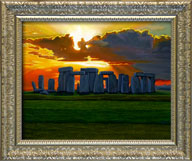
Stonehenge Series I - Mog Ruith (Celtic), 16 x 20 inches, Oil on Art Board, 2011
Mog Ruith is the one-eyed Celtic/Irish god of the sun who rides through the sky in a shining bronze chariot, or who flies through the sky like a bird. The word ruith is possibly derived from the Irish roth, meaning "wheel" (representing the sun).
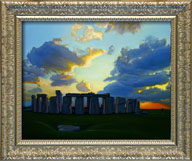
Stonehenge Series I – Apollo - Helios (Greek), 16 x 20 inches, Oil on Art Board, 2011
One of Apollo's more important daily tasks was to harness his chariot with four horses and drive the Sun across the sky.
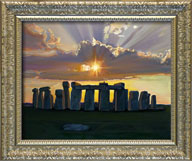
Stonehenge Series I - Khursun (Scythian), 16 x 20 inches, Oil on Art Board, 2011
Khursun was the solar god of the Scythians and Sarmatians. Khursun was later adopted by the Rus, who worshipped him as 'Khors.
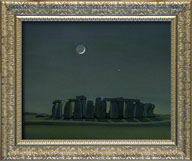
Stonehenge Series I - Luna (Roman), 16 x 20 inches, Oil on Art Board, 2011
In Roman mythology, Luna was the goddess of the Moon; daughter of the Titan Hyperion; and sister of the Sun god, Helios.
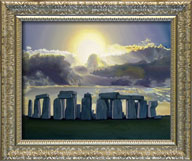
Stonehenge Series I - Mithra (Persian) 16 x 20 inches, Oil on Art Board, 2011
Mithra is an Iranian god of light and the cosmic order was known in Rome as 'Deus sol invictus' ("the unconquered sun").
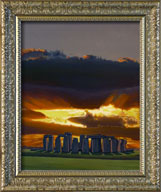
Stonehenge Series I - Sol Invictus (Roman), 20 x 16 inches, Oil on Art Board, 2011
Sol Invictus was the official sun god of the later Roman empire. Sol Invictus was adopted by the Christians in a Christian sense, as demonstrated in the Christ as Apollo-Helios in a mausoleum (c. 250) discovered beneath St. Peter’s in the Vatican.
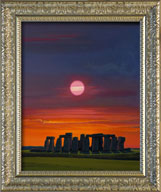
Stonehenge Series I - Aten (Egyptian), 20 x 16 inches, Oil on Art Board, 2011
Aten was the Sun god in the appearance or the solar disk, sometimes depicted with wings, sometimes with life-giving hands on rays reaching out to worshippers. Possibly the most controversial god in the history of ancient Egypt, Aten was the "one god" established by the Pharaoh Aeginetan (Ammonites I).
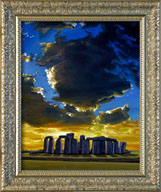
Stonehenge Series I - Surya (Hindu), 20 x 16 inches, Oil on Art Board, 2011
Surya is the supreme solar diety of Hinduism, the Supreme Light. He is said to drive through the heaven in his triumphal chariot harnessed by seven horses or one horse with seven heads, which represent the seven colors of the rainbow or the seven chakras. He presides over Sunday.
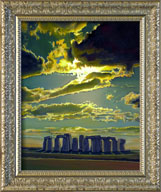
Stonehenge Series I - Shen Yi (Chinese), 20 x 16 inches, Oil on Art Board, 2011
Shen Yi was the Chinese sun god. When the heat of ten suns scorched the earth, he shot nine with his arrows and became the ruler of the remaining one.
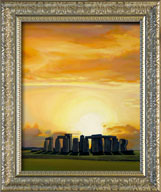
Stonehenge Series I - Tsohanoai (Navajo) –, 20 x 16 inches, Oil on Art Board, 2011
So-ha-noe-ayee - For the Navajo Indians of North America, Tsohanoai is the Sun god. Everyday, he crosses the sky, carrying the Sun on his back. At night, the Sun rests by hanging on a peg in his house.
Image size 9” x 12” (frames measure 21” x 25”) 8 Images
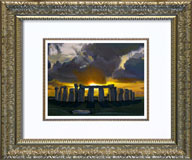
Stonehenge Series I - Kaakwha (Seneca Tribe), 9.25 x 12.25 inches, Oil on Art Board, 2011
Kanawha is the Sun, the old man of the sky who leaves his lodge to give forth light.

Stonehenge Series I - Huitzilopochtli (Aztec), 9.25 x 12.25 inches, Oil on Art Board, 2011
"Left-Handed Hummingbird", (huitzilin being Nahuatl for hummingbird), was a god of war, a sun god, and the patron of the city of Tenochtitlan as well as the national god of the Mexicas (known as Aztecs). He was a god of tremendous power who commanded terrible fear that had to be assuaged by human sacrifice.

Stonehenge Series i - Akycha (Inuit), 12.25 x 9.25 inches, Oil on Art Board, 2011
Akycha is the solar god, the spirit of the sun, worshipped by the Inuit in Alaska.
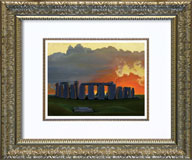
Stonehenge Series I - Ra (Egyptian), 9.25 x 12.25 inches, Oil on Art Board, 2011
Ra (or Re) was the ancient Egyptian sun god. In later Egyptian dynastic times, Ra was merged with the god Horus, as Re-Horakhty ("Ra, who is Horus of the Two Horizons"). All forms of life were believed to have been created by Ra, who called each of them into existence by speaking their secret names.
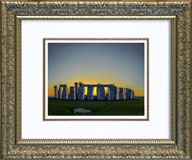
Stonehenge Series I - Hun-Apu (Mayan), 9.25 x 12.25 inches, Oil on Art Board, 2011
In Maya mythology, Hun-Apu was a son of Hun Hunahpu and a virgin. His twin was Ixbalanque; the two were the Maya Hero Twins. Their father Hun Hunahpu was beheaded by two underworld demons, Vucub Caquix and Hun Cane. Hun-Apu and Ixbalanque decided to kill their father's murderers, as well as Zipacna, son of Vucub Caquix. They made a crab decoy and told Zipacna where he could find a giant crab to eat. When Zipacna went to the spot, they threw a mountain on him, killing him. Hun-Apu became a sun god and his brother Ixbalanque became a moon goddess, switching genders.
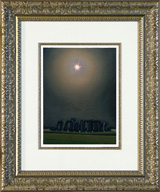
Stonehenge Series I - Hina Hine (Polynesian), 12.25 x 9.25 inches, Oil on Art Board, 2011
This Hawaiian Goddess’ name means 'woman who works the moon'. In her myths it is said that she grew tired of working for her brother and fled to the moon to live in peace.

Stonehenge Series I – Nephele (Greek), 12.25 x 9.25 inches, Oil on Art Board, 2011
Nephele was a phantom nymph molded out of clouds by Zeus in the shape of the goddess Hera. Zeus created the duplicate after Hera reported that King Ixion had attempted to violate her. Ixion was fooled by the ruse and raped the phantom, which conceived and birthed the tribe of Kentauroi (Centaurs) in a rain-shower upon Mount Pelion. The impious king was subsequently arrested and chained to a fiery wheel for all eternity.

Stonehenge Series i - Gnowee (Aboriginal), 12.25 x 9.25, Oil on Art Board, 2011
Gnowee is a solar goddess who lived on Earth before there was a sun. People had to carry torches or other light sources to see. Gnowee's baby son wandered off while she was gathering yams, and she began searching for him, carrying a large torch. So that she could see further, she climbed into the sky. Every day, she still searches for her son, and her torch is the sun.
Image size 6” x 8” (frames measure 16” x 19” ) 11 images

Stonehenge Series I - Aurora (Roman), 6.375 x 8.375 inches, Oil on Art Board, 2011
Aurora, goddess of the dawn, renews herself every morning and flies across the sky, announcing the arrival of the sun.

Stonehenge Series I - Inti (Inca), 6.375 x 8.375 inches, Oil on Art Board, 2011
Inti is Inca the sun god, as well a patron deity of the Inca Empire. His exact origin is not known. The most common story says he is the son of Viracocha, the god of civilization. He was understood to be the Giver of Life.

Stonehenge Series I – Drudugera (Papuan), 6.375 x 8.375 inches, Oil on Art Board, 2011,
Drudugera is the leg child who became the sun, in Papuan mythology. One day a woman who was in a garden near the ocean, seeing a great fish playing in the surf, walked out into the water and played with it. Some time later the woman's leg, against which the fish had rubbed, began to swell and become painful, until at last she had her father make a cut in the swelling, out of which popped a baby. The child, called Dudugera, grew up in the village, but his aggressiveness made him unpopular with the other boys. Fearing for his safety, the woman brought her son to the huge fish, who seized Dudugera in his mouth, and swam away. Before departing with his father though, Dudugera warned his mother and her relatives to take refuge behind a great rock, as he was about to become the sun. Obeying the son's advice, his mother and her relatives watched from safety as the sun burned everything, withering people, animals and plants; but to prevent the total annihilation of all, she threw lime in the face of the sun one morning, which became the clouds, which shaded the Earth from the merciless rays of the sun.

Stonehenge Series I - Wi (Oglala Sioux), 6.375 x 8.375 inches, Oil on Art Board, 2011
The Oglala mythology places their God figures in four ranks, with four deities in each rank, having prestige and precedence according to rank and place in rank. In the first rank are the Superior Gods. Wi (the Sun) is in the highest rank and is chief of all the Gods.
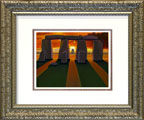
Stonehenge Series I - Uriel (Hebrew), 6.375 x 8.375 inches, Oil on Art Board, 2011
Uriel ("El/God is my light") In modern angelology, Uriel is identified variously as a seraph, cherub, regent of the sun, flame of God, and angel of the Divine Presence. Uriel is a patron of the Arts.

Stonehenge Series I - Lono (Hawaiian), 6.375 x 8.375 inches, Oil on Art Board, 2011
Lono-nui-noho-i-ka-wai – is known as the god with his head hidden in the dark clouds above. Lono’s attributes are thunder, lightening, dark clouds, rainbows, rain and wind, and clustering clouds of heaven.
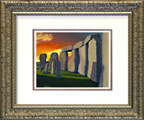
Stonehenge Series I - Shakuru (Pawnee), 6.375 x 8.375 inches, Oil on Art Board, 2011
The solar and lunar deities of the Pawnee were Shakuru and Pah, respectively. Shakura was the high god and served as an intermediary between the earth and the sky. He is the god of strength and health.

Stonehenge Series I - Amaterasu (Japanese), 6.375 x 8.375 inches, Oil on Art Board, 2011
Amaterasu is the sun goddess and one of the principal Shinto deities. The meaning of her name, Amaterasu-ōmikami, is "the great august kami who shines in the heaven".[1] She was born from the left eye of Izanagi as he purified himself in a river and went on to become the ruler of the Higher Celestial Plain. She is also said to be directly linked in lineage to the Imperial household and the Emperor , who are considered descendants.
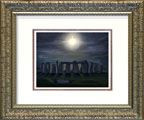
Stonehenge Series I - Epona (Roman/Celtic), 8.375 x 6.375 inches, Oil on Art Board, 2011
This horse Goddess was associated with the night and dreams. In western Ireland, legends still abound of hearing the hoof-beats of her horse as she rides west to escape the rays of the rising sun. She was also a Goddess of magic, fertility and feminine power.

Stonehenge Series I - Aotearoa (Maori), 6.375 x 8.375 inches, Oil on Art Board, 2011
Aotearoa is the Maori name for New Zealand and it means the Land of the Long White Cloud.

Stonehenge Series I - Tonatiuth (Aztec), 8.375 x 6.375 inches, Oil on Art Board, 2011
Tonatiuh (pronounced Toh-nah-tee-uh) was the Aztec sun god. This deity had both a positive and negative aspect. As a benevolent god, Tonatiuh provided humans and other living beings with warmth and fertility. In order to do so, however, he needed sacrificial victims.
Tonatiuh was also the patron of warriors, especially of the important jaguar and eagle warrior orders, among whose duties was to capture war victims to sacrifice in his honor.Tonatiuh and the Legend of the Five Suns - Tonatiuh governed the era under which the Aztecs lived, the era of the Fifth Sun. According to Aztec mythology, the world had passed through four ages, called Suns. The first era, or Sun, was governed by the god Tezcatlipoca, the second one by Quetzalcoatl, the third one by the rain god Tlaloc, and the forth one by the goddess Chalchiuthlicue. The current era, or fifth sun, was governed by Tonatiuh. According to the legend, during this age the world is characterized by maize eaters and it will violently come to an end, through an earthquake.
Image size 10” x 8” (frames measure 17.5 x 15.5 inches) 2 Images
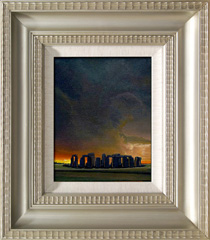
Stonehenge Series I - Tlaloc (Toltec/Aztec), 10 x 8 inches, Oil on Art Board, 2011
Tlaloc is the Aztec god of rain, agriculture, fire, and the south. In his kingdom he receives those killed by thunderbolts and water. Each year a large number of children were sacrified by drowning. He is of pre-Aztec origin and known from the time of the Toltecs. His image figures prominently in their art. He presided over the third of the five Aztec world ages.

Stonehenge Series I - Phaeton (Ancient Greek), 8 x 10 inches, Oil on Art Board, 2011
Phaeton was a young son of Helios and Klymene who begged his father to let him drive the chariot of the sun. The Sun-god reluctantly conceded to the boy's wishes and handed him the reigns.However, the inexperienced Phaethon quickly lost control of the immortal steeds, and the sun-chariot veered out of control setting the earth aflame, scorching the plains of Africa to desert. Zeus was appalled by the destruction and struck the boy from the chariot with a thunderbolt, hurling his flaming body into the waters of the river Eridanos. His sisters, the Heliades, gathered on the banks, and in their mourning with transformed into amber-teared poplar trees.
After his death Phaethon was placed amongst the stars as the constellation Auriga ("the Charioteer"), or else transformed into the god of the star which the Greeks called Phaethon--the planet Jupiter or Saturn. The name Phaethon means "the shining" or "radiant one," derived from the verb phaethô, "to shine."